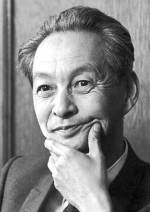Sin-Itiro Tomonaga or
Shin'ichirō Tomonaga (March 31, 1906 – July 8, 1979) was a Japanese physicist, influential in the development of quantum electrodynamics, work for which he was jointly awarded the Nobel Prize in Physics in 1965 along with Richard Feynman and Julian Schwinger.
BiographyTomonaga was born in Tokyo in 1906. He was the second child and eldest son of a Japanese philosopher, Sanjūrō Tomonaga. He entered the Kyoto Imperial University in 1926. Hideki Yukawa, also a Nobel Prize winner, was one of his classmates during undergraduate school. During graduate school at the same university, he worked as an assistant in the university for three years. After graduate school, he joined Nishina's group in Riken. In 1937, while working in Leipzig, he collaborated with the research group of Werner Heisenberg. Two years later, he returned to Japan due to the outbreak of the Second World War, but finished his doctoral degree on the study of nuclear materials with his thesis on work he had done while in Leipzig.
In Japan, he was appointed to a professorship in the Tokyo University of Education (a forerunner of Tsukuba University). During the war he studied the magnetron, meson theory, and his "super-many-time" theory. In 1948, he and his students re-examined a 1939 paper by Sidney Dancoff that attempted, but failed, to show that the infinite quantities that arise in QED can be canceled with each other. Tomonaga applied his super-many-time theory and a relativistic method based on the non-relativistic method of Wolfgang Pauli and Fierz to greatly speed up and clarify the calculations. Then he and his students found that Dancoff had overlooked one term in the perturbation series. With this term, the theory gave finite results; thus Tomonaga discovered the renormalization method independently of Julian Schwinger and calculated physical quantities such as the Lamb shift at the same time.
In the next year, he was invited by Robert Oppenheimer to work at the Institute for Advanced Study in Princeton. He studied a many-body problem on the collective oscillations of a quantum-mechanical system. In the following year, he returned to Japan and proposed the Tomonaga-Luttinger liquid. In 1965, he was awarded the Nobel Prize in Physics, with Julian Schwinger and Richard P. Feynman, for the study of QED, specifically for the discovery of the renormalization method. He died of throat cancer in Tokyo in 1979.
Tomonaga was married in 1940 to Ryoko Sekigushi. They had two sons and one daughter. He was awarded the Order of Culture in 1952, and the Grand Cordon of the Order of the Rising Sun in 1976.


























